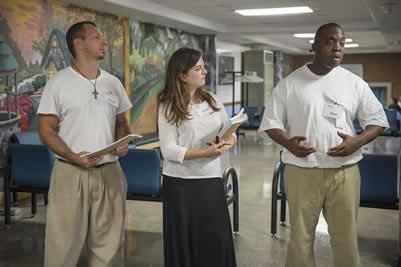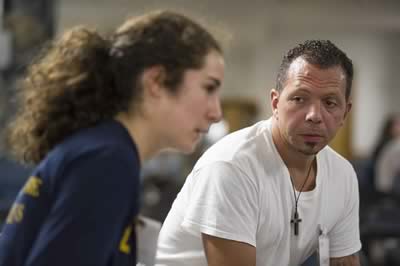On a warm and sunny September day so appreciated in cold-weather climates, 15 Notre Dame students meet in front of Siegfried Hall and pile into three minivans. They aren’t going to a football game or party.
They are going to prison.
They will drive about an hour to the Westville Correctional Facility to sit shoulder-to-shoulder with the same number of their incarcerated counterparts and discuss issues of crime, justice and prison reform. The inmates, known as inside students, and Notre Dame visitors, known as outside students, will read the same texts, write papers and have discussions in small and large groups. On this day, they talk about power and privilege and who goes to prison.
Within five minutes, I was overwhelmed by their warmth and openness. Caroline Smith, Notre Dame student
“I was pretty intimidated when we walked into our first class with the inside students,” said Caroline Smith, a senior. “But within five minutes, I was overwhelmed by their warmth and openness. I had internalized the popular stereotype of the evil, hateful convict, which I now realize is so far from reality.”
The course, Rethinking Crime and Justice, is run through Notre Dame’s Center for Social Concerns as part of the Inside-Out Prison Exchange Program, a national effort based in Philadelphia that partners institutions of higher learning with correctional facilities.
These students’ first-hand experience with prison couldn’t come at a better time. On Sept. 27, Pope Francis will continue his longstanding ministry to prisoners with a visit to the Curran-Fromhold Correctional Facility in Philadelphia as part of his first trip to the United States. He will also speak to Congress, which is working out a rare bipartisan compromise to reform the mandatory sentencing laws that have helped swell American prisons.
American jails hold 2.3 million people, a quarter of the world’s prison population, even though the U.S. represents just 5 percent of world population.
The problem is clear: American jails hold 2.3 million people, a quarter of the world’s prison population, even though the U.S. represents just 5 percent of world population. Statistics also show that race and resources play too large a role in determining who goes to prison.
In July, President Obama became the first sitting president to visit a federal prison, speaking in strikingly similar ways as the Pope about the problem. Both emphasized the economic roots of crime, the effects of incarceration on certain communities, and a new emphasis on conversion and re-integration into society.
“I’ve never seen so much momentum in my lifetime around the issue of prison reform,” said Ed Kelly, one of two Notre Dame professors teaching the course at Westville. Kelly and Susan Sharpe, an expert on Restorative Justice, created the three-credit course in 2013 in collaboration with Westville administrators.

Arriving at Westville, the outside students go through a security check and pat-down before walking through the outer gates. A long walk through the courtyard passes by a number of four-story brick buildings, oddly reminiscent of simple dormitories. The students enter a large visiting room, littered with groups of chairs, vending machines humming in one corner and some murals enlivening a few parts of the industrial blue walls.
The inside students are there, milling about in khaki pants and white tee-shirts and tennis shoes. They are black, white and Hispanic, pretty evenly divided. The groups shake hands and begin small talk with little apparent discomfort, despite being early in the semester.
They sit – alternating inside and outside students – in a large circle while the teachers discuss their papers, a reflection on the first reading. Sharpe shows a chart about wealth distribution in this country, where the top 20 percent of the population owns 80 percent of the wealth, while the bottom 40 percent can claim just .3 percent.
In some discussions, the prisoners dominate the conversation, showing they have overcome their initial fears of having the college students look down on them.
The first group discussion focuses on who goes to prison and what prisons are for. The talk aims for consensus, quickly distinguishing the ideal world from the reality. In some discussions, the incarcerated men dominate the conversation, showing they have overcome their initial fears of having the college students look down on them.
David, who is in his 40’s, said he was reluctant to take the class because he didn’t want to be treated like a “lab rat” in an experiment. But a friend who took the class last year told him it was a great experience, so he gave it a shot.

“I’ve already gotten some things out of it,” said David, who said he grew up in Lake County, Indiana, and landed in Westville for dealing drugs. “I’m able to share some thoughts about the prison system, things I can’t talk about with my family.”
One group concluded that prison is a way to warehouse the poor and uneducated.
The incarcerated men stressed that a large number of them were there for violating complex parole regulations, not a recent crime. They also dismissed the idea that potential jail time acts as a deterrent, noting that they never thought they would be caught or considered the consequences. One group concluded that prison is a way to warehouse the poor and uneducated.
Sharpe refocused one conversation that strayed to excuse making. “We have to acknowledge,” she said, “that our justice system reflects the values of a community that wants to get tough on crime. This is what many people want.”
Kevin, 21, admitted that he signed up for the class because there wasn’t much else to do to waste time in prison. But he said he’s now interested in the students’ perception of the incarcerated men and what he can learn from their success. Many are his age, though they grew up in much different circumstances.
“They’re lost when they get here,” Kevin said of the students. “They’ve seen things in movies, and they’re surprised at what it’s really like.”
Kevin says he hopes the students in the class will one day be lawyers and judges who understand the real situation better and use their resources to fix the problems. He needles one student that she needs to speak up more in the next class.
At the end of class, the inside and outside students shake hands and linger over small talk. Finally, Kelly and Sharpe let them know it’s time to head back to campus.
"It’s really a moment of pride when I see our inside and outside students come to recognize their common humanity." Ed Kelly, course co-instructor
“It’s really a moment of pride when I see our inside and outside students come to recognize their common humanity,” Kelly said.
Pope Francis has demonstrated his commitment to the Christian ideals of common humanity, forgiveness and reaching out to the marginalized in society. When he began his papacy in 2013, he washed the feet of young offenders in a juvenile detention center in Rome while celebrating Holy Thursday Mass. On a recent trip to South America, Pope Francis went to the notorious Palmasola prison in Bolivia and urged prison officials to focus on rehabilitation rather than punishment, preparing the inmates to return to society as law-abiding citizens.
Speaking to new cardinals in February, Pope Francis said that Jesus’ compassion led him to reinstate the people who are marginalized, to offer mercy to the repentant.
Francis could have been speaking to the Notre Dame students going to Westville when he said: “The way of the Church is precisely to leave her four walls behind and to go out in search of those who are distant, those essentially on the ‘outskirts’ of life.”
Kathleen Cummings, Notre Dame’s director of the Cushwa Center for Study of American Catholicism, said the Pope’s prison visit is consistent with Catholic teaching and the message of his pontificate: “God's mercy is open to everyone, and the Church should stand with the people society has forgotten or dismissed.”